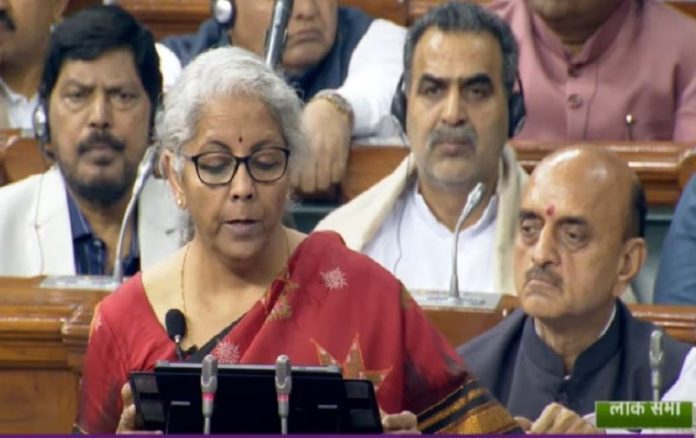
The government has created various plans, according to the Finance Minister, which would improve the nation’s infrastructure and real estate, she said during her Budget presentation. The following announcements have been made by FM with these industries in mind.
The Union Finance Minister, Nirmala Sitharaman, presented the Budget 2023–24 to the Parliament today. The government has created various plans, according to the Finance Minister, which would improve the nation’s infrastructure and real estate, she said during her Budget presentation. The following announcements have been made by FM with these industries in mind.
1. FM increased the PM Awas Yojana budget by 66%, bringing it to over ‘79,000 crore.
2. Additionally, FM recommended capping the deduction from capital gains on residential property investment under sections 54 and 54F at 10 crore. Limiting the income tax exemption from the revenues of extremely valuable insurance policies.
3. FM also suggested changing the guidelines for calculating capital gains in cases of joint property development to include the money received in the form of a cheque or other kind of payment.
4. Union Finance Minister, Nirmala Sitharama also said “While interest paid on borrowed capital for acquiring or improving a property can, subject to certain conditions, be claimed as deduction from income, it can also be included in the cost of acquisition or improvement on transfer, thereby reducing capital gains. It is proposed to provide that the cost of acquisition or improvement shall not include the amount of interest claimed earlier as deduction.”
5. FM also proposed to change the rules for calculating capital gains in cases of joint property development to include the money paid by cheque or another form of payment as consideration.
6. Cities will be enticed to increase their credit worthiness for municipal bonds by ring-fencing user charges on urban infrastructure and implementing property tax governance reforms.
7. FM said like the RIDF, an Urban Infrastructure Development Fund (UIDF) will be established through use of priority sector lending shortfall. This will be managed by the National Housing Bank, and will be used by public agencies to create urban infrastructure in Tier 2 and Tier 3 cities. States will be encouraged to leverage resources from the grants of the 15th Finance Commission, as well as existing schemes, to adopt appropriate user charges while accessing the UIDF. We expect to make available ₹10,000 crore per annum for this purpose.
8. The newly established Infrastructure Finance Secretariat will assist all stakeholders for more private investment in infrastructure, including railways, roads, urban infrastructure and power, which are predominantly dependent on public resources, said FM.
9. States and cities will be encouraged to undertake urban planning reforms and actions to transform our cities into ‘sustainable cities of tomorrow’. This means efficient use of land resources, adequate resources for urban infrastructure, transit-oriented development, enhanced availability and affordability of urban land, and opportunities for all, said FM.
10. It is proposed to provide exemption to any income arising to a body or authority or board or trust or commission, (not being a company) which has been established or constituted by or under a Central or State Act with the purposes of satisfying the need for housing or for planning, development or improvement of cities, towns and villages or for regulating any activity or matter, irrespective of whether it is carrying out commercial activity, said FM.
Atul Goel, MD, Goel Ganga Group said “The Indian real estate was looking forward to the upcoming budget, as a slew of policy overhauls and regulatory impetus were expected. In this regard, nothing has been announced and this is a little disappointing. However, the silver line is the government’s push toward urban development and infrastructure growth through increased capital investments. The overall Capex for the given fiscal has been increased to INR 10 lakh Crores, close to 3.3% of the total GDP. This will give a huge push to physical infrastructures such as highways & roadways, railway corridors, urban corridors, industrial clusters, aviation, etc. This can have a multiplier effect on the overall economy, job creation, expansion in the entrepreneurial ecosystems, and a general surge in income levels. The positive ramification of such a gigantic shift won’t just be restricted to housing but also commercial, warehouse, retail and other categories of Indian real estate. The government has also increased the allocation for PM Awas Yojna, which is a laudable step.”
Subhash Goel, Director of Goel Ganga Developments said “The Budget session is the extension of GOI’s overall commitment towards infrastructure growth, spurred urbanization, and affordable housing projects. This will be beneficial to the real estate industry, as it will set the tone for increased growth and demand. The government has allocated INR 10,000 Crore in infrastructure funds that will be managed by National Housing Board (NHB). The fund will boost infrastructure in Tier 2 and 3 cities and drive housing demand. The overall capital expenditure has been raised to INR 10 lakh Crores, almost three times than in 2019. Capital expenditure is an important cog in the wheel of economic prosperity and growth. This will also create more jobs and real estate demand. The government has also increased fund allocation for PM Awas Yojna, which will help in the mission towards providing housing for all in India.”
Gurmit Singh Arora, National President, Indian Plumbing Association said “GOI’s commitment to continuing top-class urban and rural infrastructure development in the form of higher capital investments and dedicated urban infrastructure funds also entails windfall for Indian plumbing and other related industries. The total capital expenditure will be INR 13.7 lakh Crores forming 4.5% of the overall GDP. This will translate into increased investment inflow into roadways, construction, water supplies, urban growth, logistics, etc. This in turn will drive demand for plumbing, pipelines, fittings, etc. Meanwhile, GOI has also announced to increase in the outlay towards PM Awas Yojna to INR 79,000 Crores. The thrust towards affordable housing projects will also unlock new opportunities for the plumbing businesses in India.”
Nakul Mathur, MD, Avanta India said “In the union budget, GOI has once reiterated its commitment to infrastructure development, urban growth, and the housing for all program. The effective capital expenditure will be INR 13.7 lakh Crores, forming 4.5% of the GDP. Likewise, the outlay for PM Aawas Yojna has been increased by 66% to INR 79,000 Crores. The thrust towards infrastructure development in the form of roadways, power, healthcare, railway corridors, water supplies, affordable housing programs, etc. will drive economic growth. This in turn will push demand for housing, urban communities, construction activities, office spaces, etc.”
Siddharth Maurya, Resource Specialist, Expertise Real-Estate and Fund Management said “The union budget so far has not announced any real estate-specific policy, which is a little disappointing for the Industry players. However, the industry will welcome the government’s continued policy of supporting infrastructure growth. 10,000 Crore has been allocated for infrastructure funds which will also offer an institutional framework for development in Tier 2 and 3 cities. This will drive real estate growth. Meanwhile, the capital expenditure has been increased to INR 10 lakh crores which will link infrastructure growth, economic prosperity, and real estate demand. It is noteworthy that infrastructure development is the cornerstone of a healthy real estate industry. The outlay for PM Awas Yojna has been increased by 66% to INR 79,000 Crores, which is another very prudent announcement.”
Saurabh Garg, Co-Founder and CBO, NoBroker.com said, “The announcement of the Union Budget 2023 brings positive hope for the housing sector. With the immense rise in allocation towards Pradhan Mantri Awaas Yojana to ₹79,000 crore for the next fiscal, this is expected to boost development of more low-income and affordable housing across the country.”
He added, “However, few announcements in the budget appears to be aiming towards better targeting of tax concessions and exemptions. For instance – the FM has proposed to limit the deduction from capital gains on residential property investment under sections 54 and 54F at 10 crores. Till now, there was no such limit and typically, HNIs would utilize this avenue to reduce their Capital Gains tax liability. However, it is now proposed to substantially limit the benefit available on capital gains tax arising to HNIs,” adding, “The increment in the tax rebate limit to ₹7 lakh and the reduction in the tax structure across all slabs would definitely help pumping in more liquidity in the markets. Individuals would now have more disposable income to save and invest in homes which would further propel the growth prospects of the sector.”





